+ Open data
Open data
- Basic information
Basic information
| Entry | Database: PDB / ID: 8d1g | ||||||||||||
|---|---|---|---|---|---|---|---|---|---|---|---|---|---|
| Title | hBest2 Ca2+-bound open state | ||||||||||||
 Components Components | Bestrophin-2 | ||||||||||||
 Keywords Keywords |  TRANSPORT PROTEIN / TRANSPORT PROTEIN /  Ion channel / Ion channel /  chloride channel / chloride channel /  anion channel / anion channel /  pentamer pentamer | ||||||||||||
| Function / homology |  Function and homology information Function and homology information chloride channel activity / chloride channel activity /  membrane depolarization / membrane depolarization /  chloride channel complex / chloride channel complex /  cilium / Stimuli-sensing channels / sensory perception of smell / cilium / Stimuli-sensing channels / sensory perception of smell /  plasma membrane plasma membraneSimilarity search - Function | ||||||||||||
| Biological species |   Homo sapiens (human) Homo sapiens (human) | ||||||||||||
| Method |  ELECTRON MICROSCOPY / ELECTRON MICROSCOPY /  single particle reconstruction / single particle reconstruction /  cryo EM / Resolution: 2.07 Å cryo EM / Resolution: 2.07 Å | ||||||||||||
 Authors Authors | Owji, A.P. / Kittredge, A. / Hendrickson, W.A. / Tingting, Y. | ||||||||||||
| Funding support |  United States, 3items United States, 3items
| ||||||||||||
 Citation Citation |  Journal: Nat Commun / Year: 2022 Journal: Nat Commun / Year: 2022Title: Structures and gating mechanisms of human bestrophin anion channels. Authors: Aaron P Owji / Jiali Wang / Alec Kittredge / Zada Clark / Yu Zhang / Wayne A Hendrickson / Tingting Yang /  Abstract: Bestrophin-1 (Best1) and bestrophin-2 (Best2) are two members of the bestrophin family of calcium (Ca)-activated chloride (Cl) channels with critical involvement in ocular physiology and direct ...Bestrophin-1 (Best1) and bestrophin-2 (Best2) are two members of the bestrophin family of calcium (Ca)-activated chloride (Cl) channels with critical involvement in ocular physiology and direct pathological relevance. Here, we report cryo-EM structures of wild-type human Best1 and Best2 in various states at up to 1.8 Å resolution. Ca-bound Best1 structures illustrate partially open conformations at the two Ca-dependent gates of the channels, in contrast to the fully open conformations observed in Ca-bound Best2, which is in accord with the significantly smaller currents conducted by Best1 in electrophysiological recordings. Comparison of the closed and open states reveals a C-terminal auto-inhibitory segment (AS), which constricts the channel concentrically by wrapping around the channel periphery in an inter-protomer manner and must be released to allow channel opening. Our results demonstrate that removing the AS from Best1 and Best2 results in truncation mutants with similar activities, while swapping the AS between Best1 and Best2 results in chimeric mutants with swapped activities, underlying a key role of the AS in determining paralog specificity among bestrophins. | ||||||||||||
| History |
|
- Structure visualization
Structure visualization
| Structure viewer | Molecule:  Molmil Molmil Jmol/JSmol Jmol/JSmol |
|---|
- Downloads & links
Downloads & links
- Download
Download
| PDBx/mmCIF format |  8d1g.cif.gz 8d1g.cif.gz | 368.5 KB | Display |  PDBx/mmCIF format PDBx/mmCIF format |
|---|---|---|---|---|
| PDB format |  pdb8d1g.ent.gz pdb8d1g.ent.gz | 302.9 KB | Display |  PDB format PDB format |
| PDBx/mmJSON format |  8d1g.json.gz 8d1g.json.gz | Tree view |  PDBx/mmJSON format PDBx/mmJSON format | |
| Others |  Other downloads Other downloads |
-Validation report
| Arichive directory |  https://data.pdbj.org/pub/pdb/validation_reports/d1/8d1g https://data.pdbj.org/pub/pdb/validation_reports/d1/8d1g ftp://data.pdbj.org/pub/pdb/validation_reports/d1/8d1g ftp://data.pdbj.org/pub/pdb/validation_reports/d1/8d1g | HTTPS FTP |
|---|
-Related structure data
| Related structure data |  27129MC 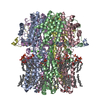 8d1eC 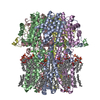 8d1fC 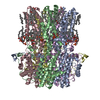 8d1hC 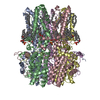 8d1iC 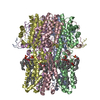 8d1jC 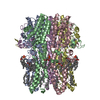 8d1kC 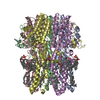 8d1lC 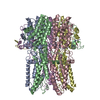 8d1mC 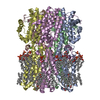 8d1nC 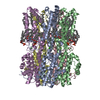 8d1oC M: map data used to model this data C: citing same article ( |
|---|---|
| Similar structure data | Similarity search - Function & homology  F&H Search F&H Search |
- Links
Links
- Assembly
Assembly
| Deposited unit | 
|
|---|---|
| 1 |
|
- Components
Components
-Protein , 1 types, 5 molecules ABECD
| #1: Protein |  / Vitelliform macular dystrophy 2-like protein 1 / Vitelliform macular dystrophy 2-like protein 1Mass: 46796.898 Da / Num. of mol.: 5 Source method: isolated from a genetically manipulated source Source: (gene. exp.)   Homo sapiens (human) / Gene: BEST2, VMD2L1 / Cell line (production host): HEK293F / Production host: Homo sapiens (human) / Gene: BEST2, VMD2L1 / Cell line (production host): HEK293F / Production host:   Homo sapiens (human) / References: UniProt: Q8NFU1 Homo sapiens (human) / References: UniProt: Q8NFU1 |
|---|
-Non-polymers , 5 types, 681 molecules 

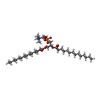






| #2: Chemical | ChemComp-CA / #3: Chemical | ChemComp-DU0 / #4: Chemical | ChemComp-MC3 / #5: Chemical | ChemComp-CL / |  Chloride Chloride#6: Water | ChemComp-HOH / |  Water Water |
|---|
-Details
| Has ligand of interest | Y |
|---|
-Experimental details
-Experiment
| Experiment | Method:  ELECTRON MICROSCOPY ELECTRON MICROSCOPY |
|---|---|
| EM experiment | Aggregation state: PARTICLE / 3D reconstruction method:  single particle reconstruction single particle reconstruction |
- Sample preparation
Sample preparation
| Component | Name: hBest2 Ca2+-bound open state / Type: COMPLEX / Entity ID: #1 / Source: RECOMBINANT | ||||||||||||||||||||
|---|---|---|---|---|---|---|---|---|---|---|---|---|---|---|---|---|---|---|---|---|---|
| Molecular weight | Value: 0.234 MDa / Experimental value: NO | ||||||||||||||||||||
| Source (natural) | Organism:   Homo sapiens (human) Homo sapiens (human) | ||||||||||||||||||||
| Source (recombinant) | Organism:   Homo sapiens (human) / Cell: HEK293F Homo sapiens (human) / Cell: HEK293F | ||||||||||||||||||||
| Buffer solution | pH: 7.8 | ||||||||||||||||||||
| Buffer component |
| ||||||||||||||||||||
| Specimen | Conc.: 5 mg/ml / Embedding applied: NO / Shadowing applied: NO / Staining applied : NO / Vitrification applied : NO / Vitrification applied : YES / Details: hBest2 Ca2+-bound open state : YES / Details: hBest2 Ca2+-bound open state | ||||||||||||||||||||
| Specimen support | Grid material: GOLD / Grid type: UltrAuFoil R0.6/1 | ||||||||||||||||||||
Vitrification | Instrument: FEI VITROBOT MARK IV / Cryogen name: ETHANE / Humidity: 100 % / Chamber temperature: 283.15 K |
- Electron microscopy imaging
Electron microscopy imaging
| Experimental equipment |  Model: Titan Krios / Image courtesy: FEI Company |
|---|---|
| Microscopy | Model: TFS KRIOS |
| Electron gun | Electron source : :  FIELD EMISSION GUN / Accelerating voltage: 300 kV / Illumination mode: FLOOD BEAM FIELD EMISSION GUN / Accelerating voltage: 300 kV / Illumination mode: FLOOD BEAM |
| Electron lens | Mode: BRIGHT FIELD Bright-field microscopy / Nominal defocus max: 2000 nm / Nominal defocus min: 1000 nm / Cs Bright-field microscopy / Nominal defocus max: 2000 nm / Nominal defocus min: 1000 nm / Cs : 2.7 mm : 2.7 mm |
| Image recording | Electron dose: 58 e/Å2 / Film or detector model: GATAN K3 BIOQUANTUM (6k x 4k) / Num. of real images: 7707 |
| EM imaging optics | Energyfilter slit width: 20 eV |
- Processing
Processing
| EM software |
| ||||||||||||||||||||||||||||||
|---|---|---|---|---|---|---|---|---|---|---|---|---|---|---|---|---|---|---|---|---|---|---|---|---|---|---|---|---|---|---|---|
CTF correction | Type: NONE | ||||||||||||||||||||||||||||||
| Particle selection | Num. of particles selected: 5459914 | ||||||||||||||||||||||||||||||
| Symmetry | Point symmetry : C5 (5 fold cyclic : C5 (5 fold cyclic ) ) | ||||||||||||||||||||||||||||||
3D reconstruction | Resolution: 2.07 Å / Resolution method: FSC 0.143 CUT-OFF / Num. of particles: 156672 / Symmetry type: POINT |
 Movie
Movie Controller
Controller













 PDBj
PDBj



